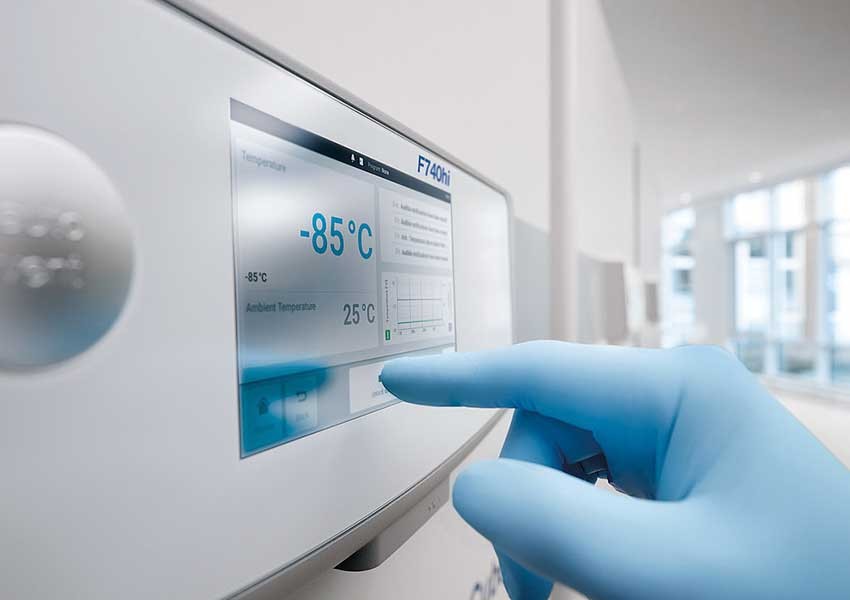Know The Process of Defrosting a Freezer in Your Laboratory

Regular defrosting is a critical part of a lab freezer maintenance process. It might seem tedious, but you cannot escape as it is necessary to ensure proper freezer temperature, make sure that ice does not take away plenty of space inside the unit, and preserve your freezer life.
Lab freezers often buildup ice on cooling elements due to condensation of the air’s humidity. As the ice thickness increases, it acts as an insulator, interfering with the unit’s cooling elements to maintain the requisite temperature. In such a situation, the freezer needs more energy to work harder to maintain the target temperature, resulting in more electricity consumption.
What is Defrosting?
When you remove ice from the cooling elements, you actuate defrosting a freezer. It helps prevent excessive electricity consumption and preserve the potency of temperature-sensitive items inside the cold storage.
There are two types of defrosting: auto and manual, and the type you should implement depends on the type of your freezer.
Auto-Defrosting
With auto-defrosting, the freezer defrosts automatically. There are two methods of actuating auto-defrosting.
The first method involves a built-in heater heating the cooling elements regularly, melting the ice buildup. The heating periods are short enough to prevent any temperature movement outside the target range but are enough to melt any ice buildup since the last heating cycle. Usually, the heating cycles occur after about 15-30 minutes.
In the second method, fans are used to generate a continuous air-flow within the freezer. It reduces the condensation on the cooling elements. With regular heating cycles, ice melts to break the ice buildup.
Despite being convenient, auto defrosting has downsides too. The moving air can dehydrate the items that are without cover. The freezer can also become less energy efficient due to the regular heating cycles. The temperature fluctuations occurring due to defrosting can also negatively impact some items.
Manual Defrosting
It involves allowing the ice to melt after the buildup reaches a stage that can affect your freezer’s performance. With manual defrosting, there will be no electricity wastage. It would help if you also planned a schedule for defrosting your freezer manually.
When to Defrost Your Freezer?
The best time to defrost your freezer is when you see ice accumulation up to the point that can affect your freezer performance.
The Centers for Disease Control (CDC) recommends that you should defrost your freezer as soon as there is an ice buildup of half an inch in thickness or if there is any change in your freezer function due to ice accumulation.
You can get some clues regarding ice buildup in your freezer, such as longer cooling times after opening and closing the door, not maintaining the target temperature, or increasing electricity consumption.
If you notice such signs, defrost your freezer immediately.
Steps in Defrosting a Freezer
You should formulate an effective plan before you defrost your lab freezer, which could also be an ultra-low temperature freezer. A good plan will help you avoid inconveniences that are likely to arise when your freezer goes offline during the defrosting.
So, it is a good idea to plan for your freezer unavailability for up to 48 hours during the manual defrost. Ensure that you have enough alternate storage space for your items in the lab freezer during the defrosting. And for temperature-sensitive items, like vaccines, there has to be an alternate freezer to store them while defrosting the unit. Communicate with all your teams to ensure adequate storage space during the defrosting period.
Once you plan for your freezer downtime, actuate the following steps while defrosting it:
- Empty the freezer and store the items in the backup storage area. Ensure that you do not leave any temperature-sensitive items in the open. If you do so, they will get spoiled.
- Turn your freezer off. And disconnect it from the power source.
- Allow the ice to melt by itself. You might get tempted to remove the ice buildup mechanically. In that case, you might end up damaging the cooling elements.
- Dry that water that accumulates due to the melting of ice. It will ensure that there will be no ice buildup immediately.
- After you see all ice melting away, turn the freezer on. But do not start filling it up with the items. Allow some time for your freezer to reach the target temperature before refilling it.
What to Do After Defrosting?
Once you complete the defrosting process, ensure that your staff organizes the freezer properly to make it work properly.
Check out if there is a need to defrost your freezer more frequently. If it is so, the seal might not be working correctly, allowing more air to enter into the freezer to cause ice buildup. Call up a technician to inspect the seal. However, there might be other causes, such as opening the door frequently. You can shift the items that are frequently retrieved.
Assign each of your staff members designated compartments in your freezer to make the task of taking out items quickly, minimizing the time for opening and closing the door.
Conclusion
Lab owners should not fall behind in defrosting their lab freezers. Defrosting enables them to store temperature-sensitive items effectively and prolong their freezers’ life. When your freezer gets older, it calls for more frequent defrosting than the new units. And ensure that there is good communication among your staff members to help maintain your freezer. Apart from defrosting, carry out scheduled checks to spot any defects in your lab freezer.








